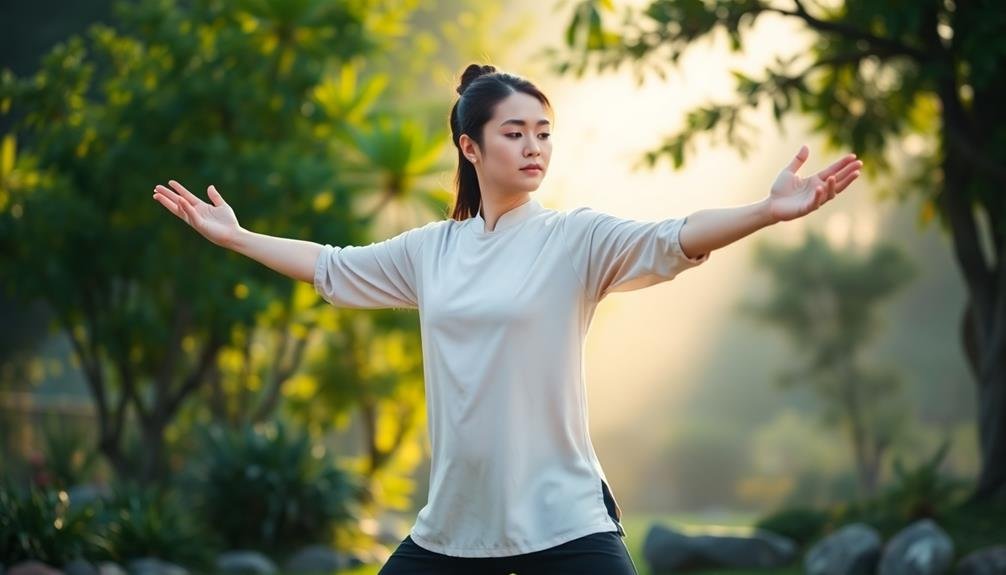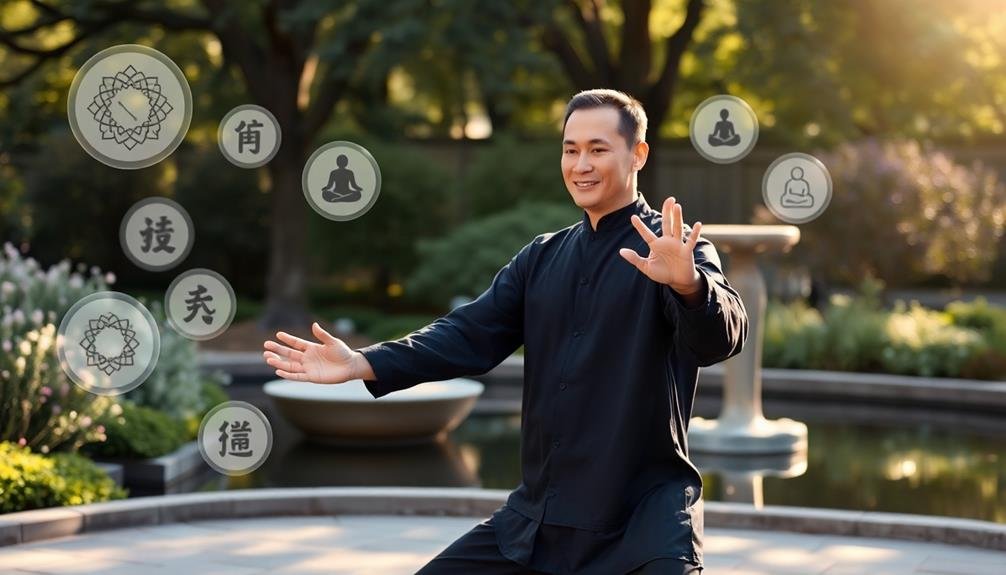Qigong offers a powerful shield against panic attacks through its unique blend of gentle movements, breathing techniques, and meditation. By practicing Qigong regularly, you'll learn to balance your body's energy, reduce anxiety symptoms, and regulate your nervous system. You'll develop skills in diaphragmatic breathing, grounding exercises, and energy circulation that can help you manage stress and prevent panic. Qigong's holistic approach aligns with Traditional Chinese Medicine, addressing both physical and emotional well-being. By incorporating Qigong into your daily routine, you'll build resilience and cultivate inner peace. Discover how this ancient practice can transform your approach to anxiety management and overall health.
Understanding Qigong and Panic Attacks

Qigong practice offers a powerful toolkit for managing panic attacks. This ancient Chinese system combines gentle movements, breathing techniques, and meditation to cultivate and balance your body's essential energy, or "qi." When you're facing a panic attack, Qigong can help you regain control over your physical and mental state.
Understanding the connection between Qigong and panic attacks is important. Panic attacks often stem from an imbalance in your nervous system, triggering a fight-or-flight response. Qigong addresses this by activating your body's relaxation response, counteracting the surge of stress hormones.
Through regular practice, you'll develop a heightened awareness of your body's sensations and learn to regulate your breath and heart rate. Qigong's emphasis on mindful movement and focused breathing can interrupt the cycle of anxious thoughts that fuel panic attacks.
Benefits of Qigong for Anxiety
When it comes to managing anxiety, few practices offer as many extensive benefits as Qigong. This ancient Chinese practice combines gentle movements, controlled breathing, and meditation to promote overall well-being and reduce stress. By practicing Qigong regularly, you'll experience a significant decrease in anxiety symptoms and an improved sense of calm.
Qigong helps regulate your nervous system, balancing the sympathetic and parasympathetic responses. This balance leads to reduced heart rate, lower blood pressure, and decreased cortisol levels – all key factors in managing anxiety. The mindful movements and focused breathing techniques also enhance body awareness, helping you recognize and address tension before it escalates into full-blown anxiety.
Moreover, Qigong improves sleep quality, which is often disrupted by anxiety. Better sleep contributes to improved mood and emotional resilience. The practice also boosts your energy levels and enhances your ability to concentrate, counteracting the fatigue and mental fog often associated with anxiety.
Basic Qigong Breathing Techniques

To begin your Qigong journey, you'll need to master fundamental breathing techniques.
Start with diaphragmatic breathing, which forms the foundation for all Qigong practices.
You can then progress to the counting breath method and breath visualization exercises, which will enhance your focus and energy cultivation.
Diaphragmatic Breathing Basics
Breathe deeply and consciously to master the foundation of Qigong practice. Diaphragmatic breathing, also known as belly breathing, is the cornerstone of effective Qigong techniques.
To begin, sit comfortably or lie on your back with one hand on your chest and the other on your abdomen. As you inhale through your nose, focus on expanding your belly rather than your chest. You'll feel the hand on your abdomen rise while the one on your chest remains relatively still. Exhale slowly through your mouth, allowing your belly to fall naturally. This process engages your diaphragm, a dome-shaped muscle at the base of your lungs, promoting fuller oxygen exchange.
Practice this breathing technique for 5-10 minutes daily, gradually increasing the duration as you become more comfortable. You'll notice improved relaxation and reduced stress levels.
As you progress, incorporate this breathing into your daily activities, especially during moments of tension or anxiety. Remember, diaphragmatic breathing isn't just for formal Qigong sessions; it's a valuable tool you can use anytime to center yourself and maintain calm.
With consistent practice, you'll develop a strong foundation for more advanced Qigong techniques and experience greater overall well-being.
Counting Breath Method
The Counting Breath Method serves as a foundational Qigong breathing technique that enhances focus and promotes relaxation. It's a simple yet effective way to calm your mind and bring awareness to your breath. To practice this method, find a comfortable seated position and close your eyes.
Begin by inhaling deeply through your nose for a count of four, then exhale slowly through your mouth for a count of six. As you breathe, focus on the sensation of air moving in and out of your body. Repeat this cycle for several minutes, gradually increasing the duration as you become more comfortable.
Here's a quick guide to help you get started:
| Step | Inhale | Exhale |
|---|---|---|
| 1 | Count to 4 | Count to 6 |
| 2 | Through nose | Through mouth |
| 3 | Expand belly | Contract belly |
| 4 | Focus on sensation | Release tension |
As you practice the Counting Breath Method regularly, you'll notice improved concentration and a greater sense of calm. This technique can be particularly helpful during moments of stress or when you're feeling overwhelmed. By incorporating it into your daily routine, you'll build a powerful tool for managing anxiety and promoting overall well-being.
Qigong Breath Visualization
Visualizing your breath forms a cornerstone of advanced Qigong breathing techniques. As you inhale, imagine drawing in pure, vibrant energy from your surroundings. Envision this energy as a glowing light entering your body, filling your lungs, and spreading throughout your entire being.
When exhaling, envision releasing any tension, stress, or negative emotions as a dark mist leaving your body.
To enhance your breath visualization practice, focus on these key elements:
- Color: Assign specific colors to your inhalations and exhalations
- Texture: Imagine the air having a particular consistency or feel
- Movement: Visualize the breath flowing along specific pathways in your body
- Transformation: Envision the breath changing form as it enters and exits your body
Grounding Exercises in Qigong
Grounding exercises in Qigong offer powerful tools for emotional stability and physical balance.
You'll learn to root yourself through specific Qigong stances, connecting your body to the earth's energy.
Rooting for Emotional Stability
Qigong's powerful grounding exercises offer a path to emotional stability and inner calm. As you practice rooting techniques, you'll find yourself better equipped to handle life's challenges and maintain balance in turbulent times.
These exercises focus on connecting your body to the earth, fostering a sense of stability and security that extends to your emotional state.
To root effectively, start by standing with your feet shoulder-width apart, knees slightly bent. Visualize roots growing from your feet deep into the earth, anchoring you firmly in place. As you breathe deeply, imagine drawing energy up through these roots, filling your body with strength and stability.
The benefits of rooting for emotional stability include:
- Reduced anxiety and stress
- Improved focus and mental clarity
- Enhanced ability to stay present in the moment
- Increased resilience in the face of emotional challenges
Earthing Through Qigong Stances
Building on the concept of rooting, earthing through Qigong stances takes your practice to the next level. These grounding exercises help you connect more deeply with the earth's energy, promoting stability and calm during panic attacks.
Start with the basic "standing like a tree" pose. Plant your feet shoulder-width apart, knees slightly bent. Imagine roots growing from your feet into the earth. As you breathe, visualize drawing energy up through these roots. Hold this stance for 5-10 minutes, focusing on the sensation of being anchored to the ground.
Next, try the "horse stance." Lower your body as if sitting on an invisible chair, feet wider than shoulder-width. Keep your back straight and arms relaxed at your sides. This pose strengthens your legs and enhances your connection to the earth.
For a more dynamic earthing exercise, practice the "pushing hands" stance. Stand with one foot forward, knees bent, and gently push your palms forward and back. This movement helps you feel the interplay between your body's energy and the earth's.
Incorporate these stances into your daily routine to build a stronger foundation for emotional stability and panic attack prevention.
Centering Breath Techniques
At the core of Qigong practice lies the power of breath. Centering breath techniques are essential for grounding yourself and combating panic attacks. By focusing on your breath, you'll calm your mind and regulate your body's stress response.
Start with the basic Qigong breathing method: inhale slowly through your nose, allowing your abdomen to expand, then exhale gently through your mouth. As you practice, visualize energy flowing into your body with each inhale and tension leaving as you exhale.
To deepen your practice, try these centering breath techniques:
- Counting breaths: Count each exhale up to 10, then start over
- Box breathing: Inhale for 4 counts, hold for 4, exhale for 4, hold for 4
- Ocean breath: Create a soft "ha" sound in your throat while breathing
- Alternate nostril breathing: Close one nostril, inhale, switch, exhale, repeat
Incorporate these techniques into your daily routine, practicing for at least 5-10 minutes each day.
As you become more proficient, you'll find it easier to center yourself during stressful situations, effectively warding off panic attacks and maintaining a sense of calm.
Energy Circulation and Panic Prevention

Harnessing the power of energy circulation, Qigong practitioners can effectively prevent panic attacks and manage anxiety. By focusing on the flow of qi, or life energy, throughout your body, you'll create a sense of balance and calm that counteracts the onset of panic.
To begin, visualize energy flowing from the earth, up through your feet, and circulating through your entire body. As you practice this technique, you'll become more attuned to areas of tension or blockage. When you feel panic approaching, direct your attention to these areas and imagine the energy smoothly passing through them.
Incorporate gentle movements, such as swaying or arm circles, to enhance energy circulation. These motions help distribute qi evenly, reducing the likelihood of panic-inducing energy buildups. Remember to breathe deeply and rhythmically as you move, syncing your breath with the flow of energy.
Regular practice of these energy circulation techniques will strengthen your ability to prevent panic attacks. You'll develop a heightened awareness of your body's energy state, allowing you to intervene early when anxiety begins to surface.
Qigong Meditation for Emotional Balance
Deeply rooted in ancient wisdom, Qigong meditation offers powerful techniques for achieving emotional balance. By combining breath work, gentle movements, and focused intention, you'll create a harmonious flow of energy throughout your body and mind. This practice helps you cultivate inner peace and resilience, effectively shielding you from the grip of panic attacks.
To begin your Qigong meditation journey, find a quiet space and adopt a comfortable seated or standing position. Focus on your breath, allowing it to become slow and deep. As you inhale, visualize healing energy entering your body, and as you exhale, imagine tension and negative emotions leaving you.
Incorporate these key elements into your practice:
- Mindful awareness of your body and surroundings
- Gentle, flowing movements that align with your breath
- Visualization of energy circulating through your body
- Affirmations or mantras to reinforce positive emotions
Regular Qigong meditation practice will help you develop greater emotional stability and self-awareness. You'll find yourself better equipped to handle stress and anxiety, reducing the frequency and intensity of panic attacks.
Incorporating Qigong Into Daily Routine

Throughout the day, take short Qigong breaks.
During lunch, practice mindful eating and focus on your breath for a few minutes.
At your desk, perform seated Qigong exercises to relieve tension and boost energy.
Before bed, engage in a calming Qigong routine to promote better sleep.
Integrate Qigong principles into your daily activities.
Practice mindful walking during your commute, focusing on your breath and body awareness.
Use visualization techniques while waiting in line or during idle moments.
Incorporate Qigong breathing exercises during stressful situations to maintain emotional balance.
As you consistently practice Qigong, you'll notice its positive effects on your overall well-being.
Remember, consistency is key.
Even small, regular doses of Qigong can lead to significant improvements in managing panic attacks and reducing stress levels.
Tai Chi Movements for Anxiety
When anxiety strikes, you can turn to Tai Chi movements for relief.
Focus on slow, mindful breathing techniques as you perform gentle, flowing motions to calm your mind and body.
Ground yourself through deliberate movements, connecting with the earth beneath your feet and allowing tension to dissipate with each step.
Slow, Mindful Breathing Techniques
Practitioners of Tai Chi often find solace in slow, mindful breathing techniques to combat anxiety. These methods help calm your mind and body, allowing you to regain control during stressful situations.
To start, find a comfortable position, either sitting or standing. Focus on your breath, inhaling deeply through your nose and exhaling slowly through your mouth. As you breathe, imagine tension leaving your body with each exhalation.
One effective technique is the 4-7-8 method. Inhale for 4 counts, hold for 7, and exhale for 8. This pattern helps regulate your nervous system and promotes relaxation.
Another approach is diaphragmatic breathing, where you focus on expanding your belly rather than your chest as you inhale.
Incorporate these breathing techniques into your daily routine:
- Practice for 5-10 minutes upon waking
- Use during breaks at work or school
- Implement before bed to improve sleep quality
- Apply during moments of heightened stress or anxiety
Grounding Through Movement
Building on the foundation of mindful breathing, Tai Chi offers physical movements that further ground you during anxious moments. These gentle, flowing exercises help you connect with your body and redirect your focus away from anxious thoughts.
Start with the basic "Standing Like a Tree" pose: stand with feet shoulder-width apart, knees slightly bent, and arms relaxed at your sides. Imagine roots growing from your feet into the earth, anchoring you firmly.
Next, try the "Wave Hands Like Clouds" movement. Shift your weight to one leg, then slowly move your arms in circular motions as if parting clouds. This rhythmic motion promotes a sense of calm and balance.
Another effective technique is "Brush Knee and Push": step forward while pushing one hand out and bringing the other hand down past your knee. This movement helps release tension and promotes a feeling of strength and stability.
As you practice these Tai Chi movements, focus on your breath and the sensations in your body. You'll find that combining mindful breathing with gentle movement creates a powerful tool for managing anxiety and panic attacks.
Qigong Postures for Stress Relief

Qigong offers a variety of postures specifically designed to alleviate stress and promote relaxation.
These postures, when practiced regularly, can help you build resilience against panic attacks and manage everyday stressors more effectively.
One of the most beneficial postures is the "Standing Like a Tree" pose. To practice this, stand with your feet shoulder-width apart, knees slightly bent, and arms curved as if hugging a large tree. Hold this position for several minutes, focusing on your breath and imagining roots growing from your feet into the earth.
Another powerful posture is the "Lifting the Sky" movement. Start by standing with your feet hip-width apart, then raise your arms slowly in front of you, palms facing up, as if lifting a heavy object. As you reach overhead, tilt your head back slightly, then lower your arms and head to the starting position.
These postures can:
- Calm your nervous system
- Improve energy flow throughout your body
- Enhance mind-body connection
- Increase overall sense of well-being
Visualizations in Qigong Practice
Visualization techniques form an essential component of Qigong practice, enhancing its effectiveness and deepening the mind-body connection. As you engage in Qigong, you'll use your imagination to guide energy through your body, promoting balance and healing.
One common visualization involves picturing a bright, golden light entering your body through the crown of your head. You'll mentally direct this light to flow down your spine, through your limbs, and out your fingertips and toes. This technique helps you focus on energy circulation and can alleviate tension in specific areas.
Another powerful visualization is the "Inner Smile." You'll imagine a warm, gentle smile radiating from your heart center, spreading throughout your body. This practice cultivates positive emotions and can reduce stress and anxiety.
You can also visualize yourself as a tree, with roots extending deep into the earth and branches reaching toward the sky. This imagery helps ground you and connect you to nature's energy.
Qigong and Traditional Chinese Medicine

Rooted in ancient Chinese philosophy, Qigong forms an integral part of Traditional Chinese Medicine (TCM). This holistic approach to health and wellness integrates movement, breath, and meditation to balance your body's energy or "qi."
In TCM, it's believed that imbalances in this energy flow can lead to various health issues, including panic attacks.
When you practice Qigong, you're not just exercising; you're actively participating in your healing process. TCM practitioners often recommend Qigong as a complementary therapy to other treatments.
It's believed to:
- Regulate the flow of qi throughout your body
- Strengthen your organs and immune system
- Calm your mind and reduce stress
- Improve your overall physical and mental well-being
Building a Consistent Qigong Practice
Establishing a consistent Qigong practice is essential for reaping its full benefits. To build a regular routine, start by setting aside a specific time each day for your practice. Mornings are often ideal, as they allow you to begin your day with a sense of calm and focus. Choose a quiet, comfortable space where you won't be disturbed.
Begin with short sessions, perhaps 10-15 minutes, and gradually increase the duration as you become more comfortable. Consistency is more important than length, so it's better to practice for a shorter time daily than to have longer, infrequent sessions. Set realistic goals and be patient with yourself as you develop your practice.
Incorporate a variety of Qigong exercises to keep your routine engaging and target different aspects of your well-being. Consider using guided videos or apps to help you stay motivated and learn new techniques.
Join a local Qigong class or find an online community for support and accountability. Remember, it's normal to face challenges when building a new habit. If you miss a day, don't be discouraged – simply resume your practice the next day.
Combining Qigong With Other Therapies

Qigong's versatility allows it to complement numerous other therapeutic practices seamlessly. When dealing with panic attacks, you'll find that combining Qigong with other therapies can enhance your overall treatment strategy.
Cognitive Behavioral Therapy (CBT), for instance, pairs well with Qigong, as both focus on mindfulness and changing thought patterns. You can use Qigong breathing techniques during CBT sessions to manage anxiety in real-time.
Incorporating Qigong into your existing wellness routine can amplify its effects. Consider integrating it with:
- Yoga: Combine Qigong movements with yoga poses for a more holistic practice
- Meditation: Use Qigong as a moving meditation to deepen your mindfulness practice
- Acupuncture: Practice Qigong between sessions to maintain energy flow
- Massage therapy: Perform Qigong exercises before or after massages to enhance relaxation
Frequently Asked Questions
Can Children Practice Qigong for Anxiety Management?
Yes, children can practice qigong for anxiety management. You'll find it's a gentle, safe technique that can help your child learn to relax, focus, and manage stress. It's easy to adapt for kids and can be fun.
How Long Does It Take to See Results From Qigong Practice?
You'll notice initial benefits from qigong within a few weeks of consistent practice. However, significant results often take 2-3 months. Don't get discouraged; keep at it. Everyone's journey is unique, so stay patient and committed.
Are There Any Potential Side Effects or Risks of Practicing Qigong?
You'll find qigong is generally safe, but there are potential risks. You might experience dizziness, headaches, or muscle soreness if you overdo it. It's important to practice under guidance and listen to your body's signals.
Can Qigong Be Practiced During Pregnancy to Manage Anxiety?
You can practice gentle Qigong during pregnancy to manage anxiety. It's generally safe, but you should consult your healthcare provider first. Always listen to your body, avoid strenuous movements, and focus on breathing and relaxation techniques.
Is It Necessary to Have a Specific Spiritual Belief to Practice Qigong?
You don't need specific spiritual beliefs to practice qigong. It's rooted in traditional Chinese medicine and philosophy, but you can approach it as a physical and mental exercise without embracing any particular spiritual system. It's open to everyone.
In Summary
You've learned how Qigong can be a powerful tool against panic attacks. By incorporating these ancient practices into your daily routine, you're building a shield of calm and resilience. Remember, consistency is key. Keep practicing your breathing, grounding, and energy circulation techniques. As you master Qigong, you'll find yourself better equipped to face anxiety head-on. Don't hesitate to combine Qigong with other therapies for a holistic approach to mental wellness.





Leave a Reply